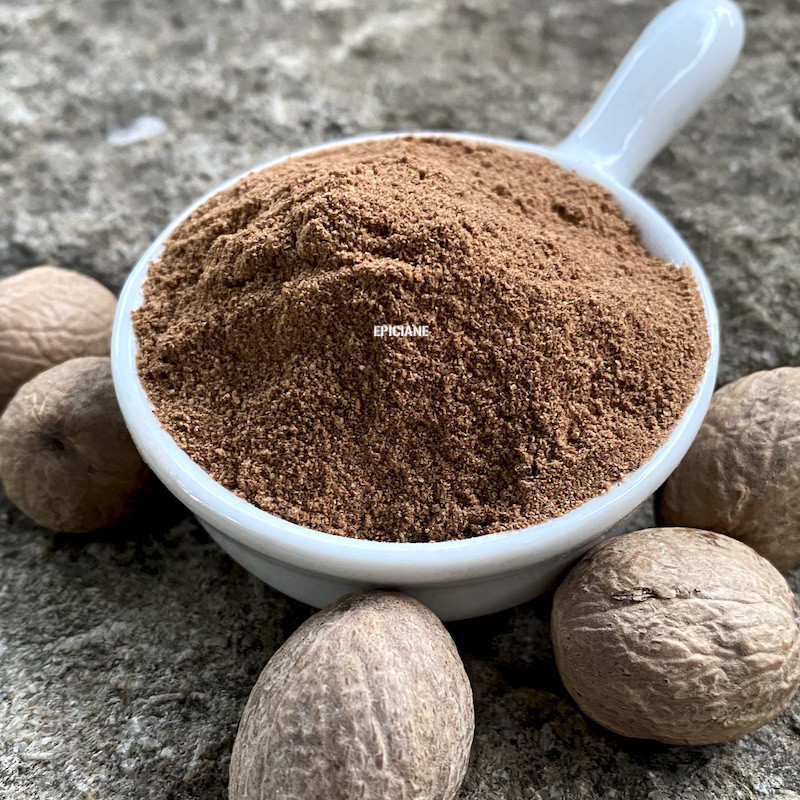
Reference: 00723801


Its unique flavor, both woody and exotic with a hint of fireplace warmth, has become essential in Western cuisine.
It adds a delightful aroma to gratins, purees, béchamel sauces, quiche lorraine, and even certain pastries, such as gingerbread.
 Delivery
Delivery
Mondial Relay
 Returns
Returns
See conditions
 Payments
Payments
100% secure
Livré en sachet refermable
Culinary Uses:
Ground nutmeg is made from finely milled nutmeg, making it much easier to use than whole nutmeg, which needs to be grated. It adds a rich aroma to meats, purees, béchamel sauces, stuffing, gratin dauphinois, quiche lorraine, charcuterie, cocktails, pastries (like gingerbread), and many other dishes.
Nutmeg is also part of the "four-spice" blend and a key ingredient in numerous exotic spice mixes, including some curries. It pairs frequently with cloves, cinnamon, and chili peppers, complementing a wide range of spices! Nutmeg is one of the rare spices that work well in both savory and sweet dishes, and it holds up well to cooking heat, preserving its distinct flavor.
Interestingly, nutmeg is also one of the ingredients in Coca-Cola.
Who am I?
Origin: Indonesia
Scientific name: Myristica fragrans
Nutmeg is the fruit of the nutmeg tree, a tropical tree in the Myristicaceae family that can reach heights of 10 to 15 meters. The tree produces orange flowers, followed by yellow-orange fruits that open when mature, revealing the oval nutmeg seed inside.
Understanding nutmeg as it appears before grinding is similar to imagining a walnut. The fruit has a large, inedible husk, within which lies a hard-shelled nut covered in a vivid red skin when fresh, and light brown once dried. This red skin is known as mace, prized for its own unique flavor. Once the mace is carefully removed, the hard shell beneath must be cracked open to access the nutmeg seed we know—a "Russian doll" of layers!
In extremely high doses, which are impossible to reach in cooking, nutmeg is toxic and can cause hallucinations, high fever, indigestion, and even death. However, don’t worry—the amounts required are so large they are impossible to consume, even intentionally!
A Bit of History:
Originally, nutmeg trees grew only on Banda Island in the Moluccas Archipelago of Indonesia. In the 15th century, the Portuguese tried to dominate the spice trade, but it was ultimately the Dutch, through the "Dutch East India Company," who expelled the Portuguese and established a monopoly, tragically carrying out massacres against the native population.
Much later, nutmeg trees were exported to the Caribbean and Grenada, where they successfully adapted.
Data sheet
 Anne-Marie A.
Anne-Marie A.
Un classique

 Anne-Marie A.
Anne-Marie A.
Un classique

Reference: 00723801
Reference: paindepices
Reference: quatreepices
Reference: 00029083-0001
Reference: 00033929-0001
Reference: 208037909
Reference: 3N7201902
Reference: 208037910
Reference: 30803202
Reference: 00723801
Reference: 20701706
Reference: Harissa
Reference: 20820902
Reference: 2071570
Reference: 3N7137901
Reference: 6L5609803
Reference: gingembreM
Reference: 20211003
Reference: EPI2301003

Its unique flavor, both woody and exotic with a hint of fireplace warmth, has become essential in Western cuisine.
It adds a delightful aroma to gratins, purees, béchamel sauces, quiche lorraine, and even certain pastries, such as gingerbread.